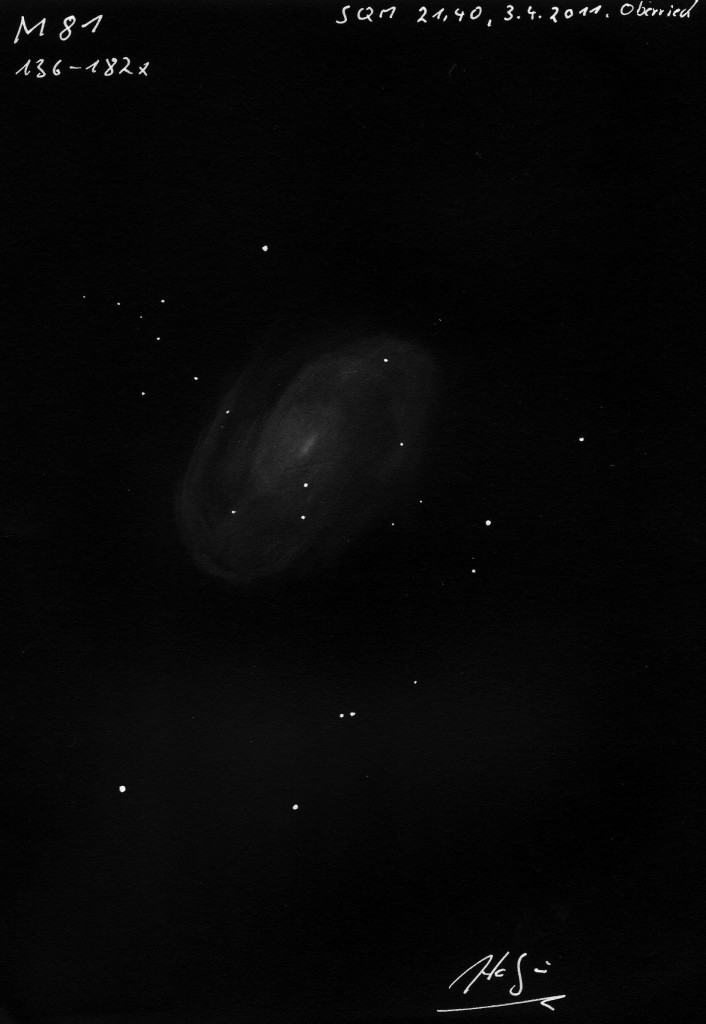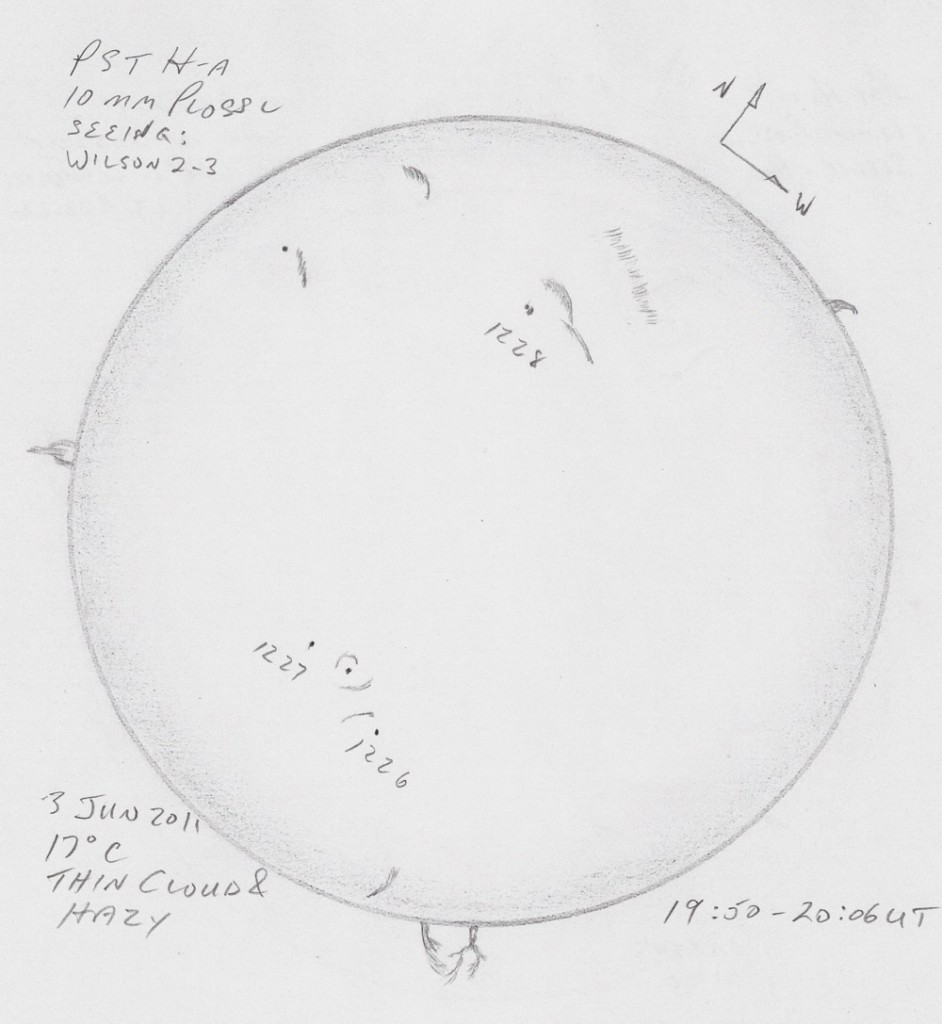
16″ 136-182x GG 6m5// SQM 21,40 without Lense// Oberried/Allgäu/Germany 3.4.2011
Lg from Hans-Jürgen
www.astromerk.de

16″ 136-182x GG 6m5// SQM 21,40 without Lense// Oberried/Allgäu/Germany 3.4.2011
Lg from Hans-Jürgen
www.astromerk.de

Hi,
Sun sketch made on 3 June 2011 at 19:50 – 20:06 UT in Ontario Canada with a Coronado PST Ha single stack. An interesting prom appears in the SSW
The disk image is pre-printed at 16 cm diameter on computer paper and details added with mechanical pencil, scanned into my computer and contrast-adjusted with standard scanner software.
Regards,
Mel R.
Hi all,
Scope time has been very scarce this year. This sketch was done in April.
Encouraged by my attempt at Eta Carina through my 8″ dob, I trained my 17.5″ dobbie at the same target, again from Sydney.
This time, I also used my Grand Daddy of all eyepieces, a 35mm Masuyama. A bit long for this f/4.5 scope, but my only OIII filter was a 1.25″.
Eta Carina is not only huge, it is a very busy place. There are multiple shockwaves within it, masses of star formation both just initiated in the form of dark pillars, of those whose nuclear fires have just kicked in, nebulae within nebulae, and a super massive star about to go supernova.
This magnificent NASA site shows all of these details.
Again, the Homunculus Nebula is too small at 57X, but the supermassive star, Eta Carina, it is associated with is the bright reddish one.
Armed with a battery of sketching implements, the result of 3hrs is below. Ooooohhh, I am going to have soooooo much fun redoing this one at a dark sky site!
Scope: 17.5″ f/4.5 dob
Gear: 35mm Masuyama, 57X, OIII filter
Date: April 8, 2011
Location: Sydney
Media: white pastel, white & black charcoal pencils, white chinagraph, white and coloured ink on black A4 size paper
Cheers,
Alex M.
Object Name: Gassendi crater
Object Type: Moon
Location: Budapest, Hungary
Date: 14th April 2011
Media: Graphite pencil on white paper. No digital tools used
Equipment used: 130/650 SW 130x, 5 mm Planetary ocular
The weather was awful, what to say: I had approximately 30 minutes to sketch. However, I liked this crater very much, so I tried my best to draw it. I quickly done a sketch then worked out my final draw in the room when all the milky clouds covered the Moon.
dr. Hannák Judit
hannak.judit@gmail.com
object name: Zachz crater
object type: lunar crater
location: Hungary, Gödöllő
date: 12,02,2011. UT. 17h 12m
medium:Withe paper graphite pencil.
instrument: 200/1200 Newton
S: 10/7-8
T: 5/4
The choice of the Hungarrian-born astronomer Xavér Zach (1754-1832 ) crater was named after. The crater is located southeast of the Clavius.
Róbert Nagy Gödöllő.
Hello!
Last night I and my Friends we have a great observation night in Oderne, in south Poland – beautiful place among Beskid mountains. We have very good, clear sky but there was very chill. We have very low temperature at night. About -20°C (about -4°F). In central Europe during the Winter, it is nothing strange. But it is necessary to be a tough to make all night observations in this conditions 😉
After many hours of the good observations we take a little nap. We have resumed our observations at 4 AM to get the first Venus and Saturn since few months.
There was intense, severe frost.
Object: Planets Venus and Saturn
Scope: SCT 5″ with SW UWA58 9mm
Time and date: December 5th, 2010. About 4:00 AM
Place: Oderne, Poland
Weather: Clear, dark sky. Heavy frost.
Technique: Graphite pencil
Tooling: Some correction with PhotoShop
Observer: Aleksander Cieśla (Wimmer)
I have a interesting foto from that observations.
There was really heavy frost. After all my equipment was operating quite good 🙂 There was strange noise from motors of my Celestron SLT mount, like howling 😉 But all night long it was operating correctly. I have little problems with corrector plate of my C5 SCT too, but dew shield works not bad. Most problems we have with the eyepieces. Puting the eyepiece to the poket at several minutes – that was an easy solution of this problem.
During that night my equipment looks like that: 🙂
Thank You, and sorry for my bad english.
2010 10 16, 2351 UT – 2010 10 17, 0142 UT Rupes Recta
PCW Memorial Observatory, OH, USA, Erika Rix
Zhumell 16”, 20mm TV, 3x Barlow, 270x mag, 13% T moon filter
Temp: 7°C, 59% humidity, S: Antoniadi II, T: 2.5/6
Sketch created scopeside with Rite in the Rain paper and charcoal.
Phase: 65.2°
Lunation: 9.33d
Illumination: 70.9%
Lib. Lat: -3°50’
Lib. Long: +2°56’
Az: 209°37’, Alt: 32°06’
Rupes Recta: Scarp, 7.7° W, 22°S
Imbrian period (-3.8 billion yrs to –3.2 billion yrs)
Length: ~110 km, Height: 240-300 m, Apparent Width: 2.5 km
Located in Mare Nubium, this scarp, also known as the Straight Wall, was
apparent by the shadow cast from illumination from the east. The shadow
wasn’t very wide, but rather narrow and smudging to the west. The
eastern side of it was crisp and sharp. During the waning phase, this
same feature would appear as a white line from the illumination coming
from the west. The slope incline is ~30-40° (ref. Virtual Moon Atlas).
For a good comparison between the waning and waxing phases for this
feature, please have a look at this site:
http://www.astrosurf.com/lunascan/Rupesr.htm
Lightened areas around Birt (Copernician period) made a path from the
crater to the fault, showing off Birt A as well as a “V” shaped area
nestled between Birt and the companion craters K, J, and H (you will
have to look at an atlas for those craters as I wasn’t able to see them
during my observation last night).
The ridges to the south of Rupes Recta formed what I always pictured as
a scoop, make the ridge and the fault look like a ladle. Funny that a
woman should think of it a ladle whereas 17th century selenographer
Christiaan Huygens reckoned it looked more like a sword (ref. Modern
Moon, page 147). A lightened area to the south (top of the scarp in my
sketch from last night) outlined the circular ridge of Thebit S. It’s a
pity it wasn’t more defined during my observation. What I found very
interesting to observe was the darkened cirlce that Rupes Recta and the
wrinkle ridges to the west formed. I believe the ridges to the east
outline the ancient crater that Chuck Wood dubbed Ancient Thebit in the
Modern Moon.
Rima Birt looked more like a thin shadow than a rille. Looking back to a
sketch I rendered in 2005 using an LX200 Classic, not only was this
rille visible, but I also caught Birt E, which I didn’t see during last
night’s observation.
Resources
Rukl plate: 54 Birt
“The Modern Moon” by C. Wood pg. 146-147
Lunar Orbiter:
http://www.lpi.usra.edu/resources/lunar_orbiter/bin/info.shtml?300
Best regards,
Erika Rix
www.pcwobservatory.com
Object : Comet 103P/Hartley and Open Clusters NGC 884 / NGC 869
Date : October 07, 2010
Time : 19:00-20:00 LST / 02:00-03:00 UT
Location : Wittmann, Arizona USA
Medium : Charcoal pencils, fine markers, painting brush, windows paint for inversion and color touch up, white paper.
Magnitude : comet-( ~7,5 or 8) open clusters combined magnitude of ( 4.2)
Weather : New Moon!, dark and clear skies, no clouds, no winds, ambient temperature of 85 deg. F.
Comments :
I finally gave it a try to sketch this all inclusive view of the Double Cluster and comet Hartley. The naked eye open clusters of NGC 869 and NGC 884 are clearly visible, but the elusive comet 103P/ Hartley is still a bit of a challenge to notice without the aid of binoculars or a rich field telescope. Comet Hartley is so diffused it was reported to have a 31 arcminute coma as of the date of this report. Depending on how much light pollution you are pestered with, that might keep you from seeing the comet in its entirety- or you may be looking at only the brighter portion of the nucleus. Speaking of brightness, I was able to compare its magnitude to some defocused stars nearby and I conclude to estimate it at 7.5 or 8. Obviuosly not a naked eye object, just yet! It would’ve been nice to detect the color but the diffused nature of comet Hartley doesn’t bring out the green hue comets are associated with. Right now only in photographs will you enjoy that treat.
The Double Cluster with an average magnitude of 4.2 is best appreciated under the view of binoculars. From the city, it’s hard to notice the the faint misty glow, but from rural areas, it stand out almost immeadiately if not with averted vision. Through the binoculars or a 4 to 6 inch telescope the clusters show their true beauty. Mostly composed of young blue stars, they also host a sprinkled few orange stars that add to the visual interest. Both are great low magnification targets to be admired. Keep looking, keep sketching, keep submitting, maybe comet Hartley has a surprise for us in the next few weeks!
Dark and clear skies,
Juanchin